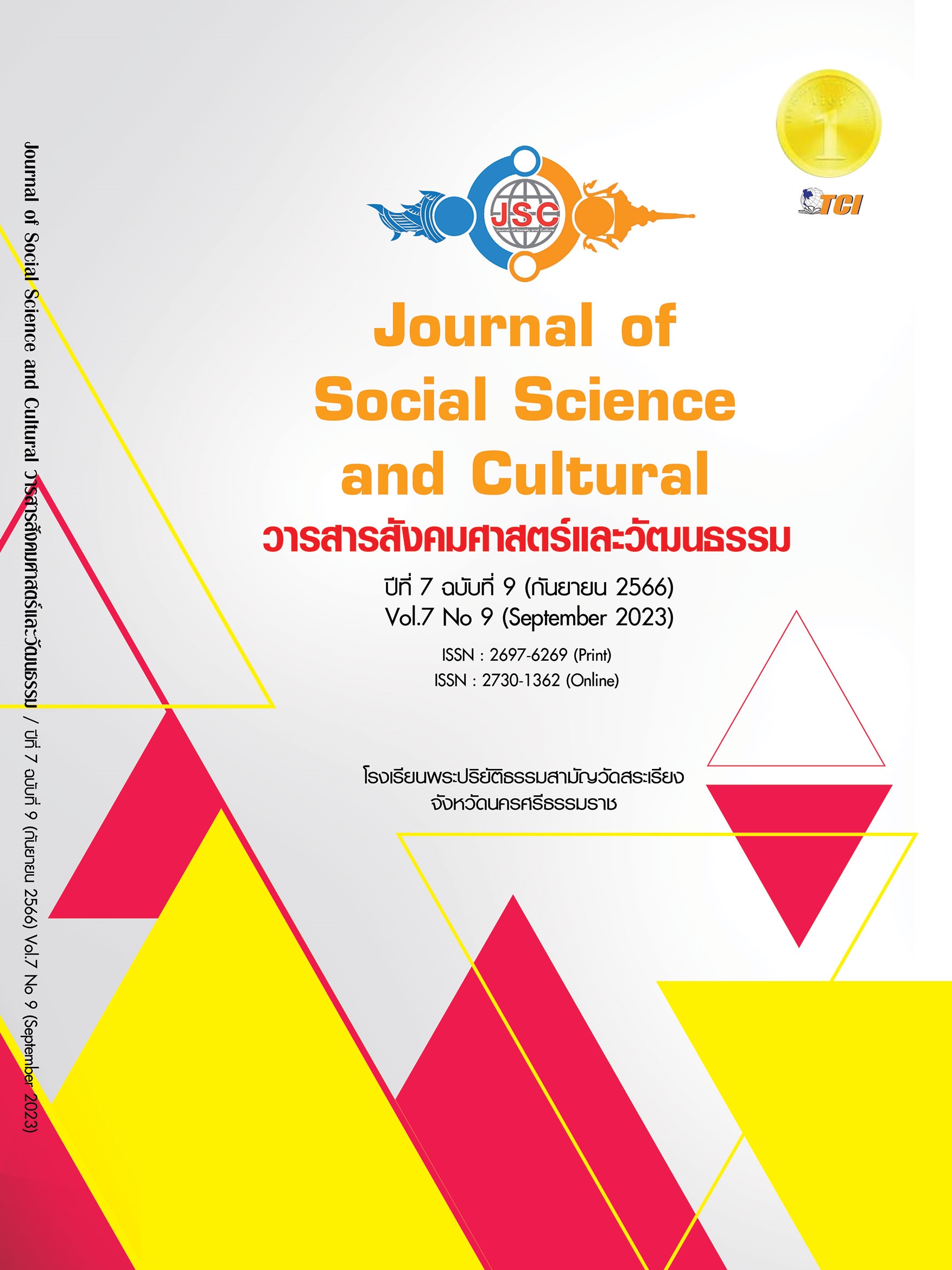“ECO-FRIENDLY CLOTHING”, A FORM OF COMMUNICATION FOR SUSTAINABLY PARTICIPATIVE ATTITUDES
Main Article Content
Abstract
The "Saving the Planet Trend" or environmental awareness affects our lives. Climate change causes social and economic difficulties that impact people's health and livelihoods all around the world. The trend of saving the planet has influenced people to consider buying consumer goods using ecologically friendly manufacturing processes. This academic article presents "Eco-Friendly Clothing" as a form of communication for a sustainable mindset that is supposed to stimulate involvement in efforts to decrease the effect of environmental challenges that people are currently experiencing. The author presents the concept of an eco-friendly clothing communication form, clothing design that focuses on the environment based on customer behavior and perspective. At the moment, the fashion industry has adapted and improved the clothing supply chain to be more sustainable by utilizing textile waste from the fashion industry's production or post-consumer textile waste, such as clothes that are no longer required to be upcycled so that they are not wasted. To replace the consumption of primary resources, new materials are being found from agricultural waste in the textile manufacturing process. Furthermore, the communication form is demonstrated and distributed to the public via eco-friendly clothing to highlight the elements of sustainability communication through design. The author anticipates a shift in perspectives toward sustainability in terms of ideas, sentiments, and actions in order to live a balanced and productive life for everyone.
Article Details
References
เจนนิเฟอร์ ชวโนวานิช. (2565). เพราะเหตุใดสิ่งที่เราสวมใส่จึงเป็นเรื่องสำคัญ. เรียกใช้เมื่อ 1 สิงหาคม 2566 จาก https://www.gqthailand.com/views/article/why-the-way-we-dress-is-important
จันทร พันธ์ภักดีวงษ์. (2559). การรับรู้ด้านสิ่งแวดล้อมและการทำกิจกรรมทางสังคมเพื่อสิ่งแวดล้อมของธุรกิจที่ส่งผลต่อการตัดสินใจซื้อรถยนต์อีโคคาร์ (Eco Car) ของประชากรในจังหวัดกรุงเทพมหานครและสมุทรปราการ. ใน วิทยานิพนธ์มหาบัณฑิต สาขาบริหารธุรกิจ. มหาวิทยาลัยกรุงเทพ.
จันทร์กานต์ เบ็ญจพร. (2566). ปัญหาสิ่งแวดล้อม เปลี่ยนผู้บริโภค ปรับพฤติกรรมซื้อสินค้า บริการยั่งยืน. เรียกใช้เมื่อ 1 สิงหาคม 2566 จาก https://www.bangkokbiznews.com/environment/1067826
ชวลิต ทิพพาวนิช. (2564). “ภาวะโลกรวน” เมื่อสิ่งแวดล้อมเปลี่ยนไป โลกยุคใหม่ต้องเปลี่ยนแปลง เปลี่ยนผ่านสู่สังคมคาร์บอนต่ำ. เรียกใช้เมื่อ 1 สิงหาคม 2566 จาก https://thestandard.co/amid-global-warming/
นันท์ชภรณ์ พฤกษ์เรืองกิจ. (2562). ทัศนคติต่อการเข้าศึกษาในโครงการรัสเซียศึกษาของนักศึกษา ปีการศึกษา 2561. ใน วิทยานิพนธ์ศิลปศาสตรบัณฑิต สาขารัสเซียศึกษา. มหาวิทยาลัยธรรมศาสตร์.
ปัทมาสน์ ชนะรัชชรักษ์. (2566). เอเชียต้องสูญเสียอะไรบ้างจากวิกฤตโลกรวนในปี 2022. เรียกใช้เมื่อ 1 สิงหาคม 2566 จาก https://thestandard.co/climate-change-impacts-asia/
รุ่งนภา บุญคุ้ม. (2536). ทัศนคติของพัฒนากรต่อนโยบายการจัดตั้งศูนย์สาธิตการตลาด: ศึกษากรณีศูนย์ช่วยเหลือทางวิชาการพัฒนาชุมชน เขตที่ 3. ใน วิทยานิพนธ์มหาบัณฑิต สาขาการวิเคราะห์และวางแผนทางสังคม. สถาบันบัณฑิตพัฒนบริหารศาสตร์.
วชิรวัชร งามละม่อม. (2559). ทฤษฎีการมีส่วนร่วม. เรียกใช้เมื่อ 1 สิงหาคม 2566 จาก http://learningofpublic. blogspot.com/2016/02/blog-post_79.html
สถาบันพัฒนาอุตสาหกรรมสิ่งทอ. (2562). H&M เปิดตัวคอลเลคชั่นแฟชั่นแบบยั่งยืนผลิตจากวัสดุที่เป็นมิตรกับสิ่งแวดล้อม.เรียกใช้เมื่อ 1 สิงหาคม 2566 จาก https://www.thaitextile.org/th/insign/detail.1017.1.0.html
อธิวัตร จิรจริยาเวช. (2566). การสื่อสารข้อมูลด้านความยั่งยืนสู่ผู้บริโภค. เรียกใช้เมื่อ 27 กันยายน 2566 จาก https://www.nstda-tiis.or.th/our-rd-activities/sd-data/10yfp-scp/cip/
Cohen, J. M. & Uphoff, N. T. (1980). Participation's place in rural development: Seeking clarity through specificity. World Development, 8(3), 213-235.
Kate, P. (2020). “วิกฤตธรรมชาติ” ภัยคุกคามจีดีพีโลก หวั่นธุรกิจพึ่งพาธรรมชาติมากกว่าคาด. Retrieved September 25, 2023, from https://www.salika.co/2020/06/25/asean-sei-katsu-sha-studies-2020-the-rise-of-consciouslites/
Lerksirinukul, P. (2020). “Consciouslites” กลุ่มคนที่ใส่ใจสังคม - สิ่งแวดล้อม จริงจังกับการจ่ายเพิ่มเพื่อbuycott แบรนด์. Retrieved August 1, 2023, from https://www.salika.co/2020/06/25/asean-sei-katsu-sha-studies-2020-the-rise-of-consciouslites/
Ro, C. (2020). Fashion accounts for around 10% of greenhouse gas emissions from humanactivity, but there are ways to reduce the impact your wardrobe has on the climate. Retrieved August 2, 2023, from https://www.bbc.com/future/article/20200310-sustainable-fashion-how-to-buy-clothes-good-for-the-climate
Rodiguez, B. (2019). H&M’s New Conscious Exclusive Collection Uses Sustainable Fabrics MadeFrom Fruit and Algae. เรียกใช้เมื่อ 2 August 2023 จาก https://www. thefashionspot.com/runway-news/829475-hm-conscious-exclusive- collection/
Wijngaarden, R. (2022). 1/OFF Paris: 400% Growth for The Upcycled Fashion Brand Taking Sustainability to Luxury’s Eco-Apathetic. Retrieved August 2, 2023, from https://www.forbes.com/sites/katiebaron/2022/06/27/1off-paris-400-growth-for-the-upcycled-fashion-brand-taking-sustainability-to-luxurys-eco-apathetic/?sh=36b85f9b64f8


